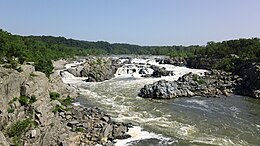Great Falls (Potomac River)
| Great Falls | |
|---|---|
 The Great Falls as seen from Northern Virginia | |
 | |
| Location | Montgomery County, Maryland and Fairfax County, Virginia, U.S. |
| Coordinates | 38°59′51″N 77°15′09″W / 38.99750°N 77.25250°W |
| Type | Steep Tiered Cascades |
| Elevation | 129 ft (39 m) |
| Total height | 47 ft (14 m) [1] |
| Average width | 350 ft (110 m) [1] |
| Run | 550 ft (170 m) [1] |
| Watercourse | Potomac River |
| Average flow rate | 16,750 cu ft/s (474 m3/s) (est.) [1] |
Great Falls is a series of rapids and waterfalls on the Potomac River, 14 miles (23 km) upstream from Washington, D.C., on the border of Montgomery County, Maryland and Fairfax County, Virginia. The Potomac and the falls themselves are legally entirely within Maryland, since the state's border follows the south bank of the river.
Great Falls Park, managed as part of George Washington Memorial Parkway, is on the southern banks in Virginia, and Chesapeake and Ohio Canal National Historical Park parkland is along the northern banks of the river in Maryland. Both are operated by the National Park Service.
The Great Falls area is popular for outdoor activities such as kayaking, whitewater rafting, rock climbing, and hiking. The Billy Goat Trail on Bear Island, and Olmsted Island, both accessible from Maryland, offer scenic views of the Great Falls. There also are overlook points on the Virginia side.
Great Falls and Little Falls (about 5 miles downstream) are named in contradistinction to one another.
History
[edit]

The rocks of the falls are about 750 million years old, dating to the late Precambrian era.[2] The rocks are a resistant metamorphized schist, gneisses, metagraywackes, and metaconglomerates.[2] The Falls themselves formed during the Last Glacial Period, about 35,000 years ago, when sea level most recently dropped, causing the Potomac to downcut its valley.[2]
The river cascades over a series of 20-foot (6.1 m) falls, dropping a total of 76 feet (23 m) in elevation over a distance of less than 1 mile (1.6 km).[3]
As sea level rises again, the power of the falls will be reduced due to a shorter vertical drop and likewise downcutting will slow down. Should the ocean level exceed the height of the falls, downcutting would reverse entirely and silt would fill in the now-underwater falls.
The Potomac narrows as it passes over the falls and through Mather Gorge. Heavy rain or snow in the watershed upstream causes white-water floods which entirely submerge the rocks and even threaten the adjacent park visitor center (built on stilts for this reason). A pillar at the Virginia overlook, well above the river, marks the level reached during the 1936 Northeastern United States Floods.
Canals
[edit]
Multiple canal systems were built around Great Falls. The remains of the Patowmack Canal, built in the 18th century, can be found on the Virginia side. The canal was commissioned by George Washington and consisted of a system of five locks to allow barges to avoid the falls.[4] Later on, the Chesapeake and Ohio Canal was built in the early 19th century on the Maryland side of the falls. It ultimately connected the Potomac tidewater with Cumberland, Maryland.[5] The Chesapeake and Ohio Canal also used the Great Falls as a feeder (now abandoned) to supply water for its own use.
References
[edit]- ^ a b c d "Great Falls, Maryland, United States - World Waterfall Database". www.worldwaterfalldatabase.com. Retrieved 2020-01-17.
- ^ a b c "The Great Falls of the Potomac, Montgomery County". Maryland Geological Survey. Retrieved June 19, 2020.
- ^ "Great Falls of the Potomac : Image of the Day". NASA. July 29, 2004. Archived from the original on October 12, 2004. Retrieved August 17, 2010.
- ^ "The Patowmack Canal - Great Falls Park (U.S. National Park Service)". www.nps.gov. October 2020. Retrieved 2023-03-16.
- ^ "History & Culture - Chesapeake & Ohio Canal National Historical Park (U.S. National Park Service)". www.nps.gov. December 2020. Retrieved 2023-03-16.
External links
[edit]- Cascade waterfalls
- George Washington Memorial Parkway
- Landforms of Fairfax County, Virginia
- Landforms of Montgomery County, Maryland
- Potomac River
- Rapids of the United States
- Tourist attractions in Fairfax County, Virginia
- Tourist attractions in Montgomery County, Maryland
- Waterfalls of Maryland
- Waterfalls of Virginia
